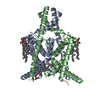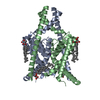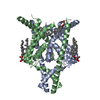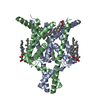+Search query
-Structure paper
| Title | C-type inactivation and proton modulation mechanisms of the TASK3 channel. |
|---|---|
| Journal, issue, pages | Proc Natl Acad Sci U S A, Vol. 121, Issue 17, Page e2320345121, Year 2024 |
| Publish date | Apr 23, 2024 |
 Authors Authors | Huajian Lin / Junnan Li / Qiansen Zhang / Huaiyu Yang / Shanshuang Chen /  |
| PubMed Abstract | The TWIK-related acid-sensitive K channel 3 (TASK3) belongs to the two-pore domain (K2P) potassium channel family, which regulates cell excitability by mediating a constitutive "leak" potassium ...The TWIK-related acid-sensitive K channel 3 (TASK3) belongs to the two-pore domain (K2P) potassium channel family, which regulates cell excitability by mediating a constitutive "leak" potassium efflux in the nervous system. Extracellular acidification inhibits TASK3 channel, but the molecular mechanism by which channel inactivation is coupled to pH decrease remains unclear. Here, we report the cryo-electron microscopy structures of human TASK3 at neutral and acidic pH. Structural comparison revealed selectivity filter (SF) rearrangements upon acidification, characteristic of C-type inactivation, but with a unique structural basis. The extracellular mouth of the SF was prominently dilated and simultaneously blocked by a hydrophobic gate. His98 protonation shifted the conformational equilibrium between the conductive and C-type inactivated SF toward the latter by engaging a cation-π interaction with Trp78, consistent with molecular dynamics simulations and electrophysiological experiments. Our work illustrated how TASK3 is gated in response to extracellular pH change and implies how physiological stimuli might directly modulate the C-type gating of K2P channels. |
 External links External links |  Proc Natl Acad Sci U S A / Proc Natl Acad Sci U S A /  PubMed:38630723 / PubMed:38630723 /  PubMed Central PubMed Central |
| Methods | EM (single particle) |
| Resolution | 3.0 - 3.68 Å |
| Structure data | EMDB-36793, PDB-8k1j: EMDB-36799, PDB-8k1q: EMDB-36805, PDB-8k1v: EMDB-36806, PDB-8k1z: |
| Chemicals |  ChemComp-Y01:  ChemComp-K:  ChemComp-HOH: |
| Source |
|
 Keywords Keywords |  MEMBRANE PROTEIN / Acid-sensitive / MEMBRANE PROTEIN / Acid-sensitive /  potassium ion channel / C-type / gating mechanism potassium ion channel / C-type / gating mechanism |
 Movie
Movie Controller
Controller Structure viewers
Structure viewers About Yorodumi Papers
About Yorodumi Papers












